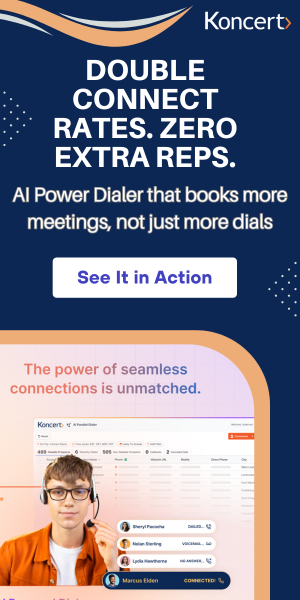
It’s the newest age-old question: cold email vs. cold call? We use both cold calling and cold emailing for starting (and continuing) conversations and B2B sales engagement with a potential customer. However, each of these tactics has supporters and haters. Cold emailing is a good alternative for those who think cold calling is dead. On the other hand, many people treat cold emails as spam and are skeptical about the results.
Cold calling is more personal than email. Many sales reps use it to schedule meetings, get referrals, or even complete a sale right then and there. However, most business people use email as their preferred method of communication.
Learn 3 steps to improving sales engagement. Read this blog.
Emailing is an inherently more convenient way to contact people, but it’s by no means the perfect vehicle for cold contacting.
The solution to the cold email vs. cold call debate? Use them together.
Joining Forces
When it comes to email and phone calls, it’s not an either/or. They each have their place in your outbound sales cadence and contribute heavily to the outcome of the final deal.
According to a survey by DiscoverOrg, 60% of over 1,000 senior executives from the IT industry reported taking an appointment or attending an event after receiving a cold call or unsolicited email. See? They both work.
Cold Emailing
Cold emails have potential. With the right research techniques and the right message, including the right cold email template, you can connect with anyone. Email also allows your prospects the convenience to read your message whenever they’re ready to receive your message.
With cadence and sequencing tools, sales reps can scale and automate certain elements, increasing the volume of outgoing cold emails.
While email may be the quick, easy way to do things, it’s certainly not the most efficient way. Fifty-seven percent of people who receive these kinds of emails believe it to be spam without even opening the email.
5 tips for cold emailing:
- Use subject lines that get your message across (and don’t be deceiving!)
- Use a tool that measures your open rates so you can see what's working
- Don't send emails that go on the defensive or are confrontational in any way.
- Use email as a way to schedule things, remind prospects of things, etc.
- Rely on emails to set up calls
It is also important to note that when you cold email, you must comply with the anti-spam laws of your prospect’s location. Read up on CASL, Can-Spam, and GDPR. The big takeaways are to make sure you’ve collected this data appropriately and informed the prospect previously of how it would be used cold emails are not spam.
Cold Calling
Emailing without cold calling is 98% less effective than following up an email with a call according to a study earlier this year. Also revealed in that same study, more outreach (using multiple methods, and sometimes reaching out twice in one day) is three times more successful than spacing engagement out more evenly as in a traditional nurture.
As you can see, cold calling can be a very effective sales tactic in your sales planning if it's done properly.
When prospects aren’t answering phone calls, sales staff might see calling as a time-consuming, repetitive task that yields a low response rate. What they miss is the role that voicemail can play in setting up the prospect for the next step in the sales process. Properly used, voicemail serves as a soft first touch point with a prospect that then leads to a more meaningful callback.
Achieving More in the Sales Cadence
Sales cadences vary greatly between individuals, teams, and organizations. However, the frequency, method of contact (phone and email), and time of contact should always be structured and consistent. It is this consistency and structure that makes for an effective sales cadence.
It’s not uncommon to use email for a certain type of outreach and dialing for another. This often comprises a consistent one-two approach that determines the sequence.
You’re more likely to reach someone by phone if you’ve previously emailed them. If the individual is screening their calls with caller ID, they are more likely to recognize your name and understand the value of talking with you.
The content of your warm up email should not be about you and what your product or service does, but rather focus on a problem that your audience has. Tell them how your company is an expert at solving that problem.
When following up after sending sales collateral, don’t just ask a prospect if they’ve read your email. Ask specific questions about the content you sent such as, “Have you had time to read my email about why cold calling is just as important as emailing?” Reminding them of your last interaction is an important step, no matter how you're reaching out to them.
Final Thoughts on the Cold Email vs. Cold Call
It’s all about creating a genuine connection with your audience. Combining these methods is all in an effort to make that connection meaningful and lead to a real conversation about your solution to their problem. It shouldn’t come as a surprise that human interaction actually works in sales. No one wants to talk to a robot, either by phone or email.
Using phone and email in tandem is the best approach for turning prospects into leads and eventually into loyal customers.Tools like TruCadence allow you to schedule calls, emails, social media messages, and reach out via text all within a single platform for a well-rounded sales strategy. Pairing that with software like the ConnectLeader Personal Dialer saves time and improves lead generation. Remember, it’s all about more communication, which means more dials, more emails, more outreach.
Reach out to us here at ConnectLeader today to learn how to increase your sales team’s productivity by up to 800% with Team Dialer and TruCadence. Simply click here or give us a call at 800-955-5040.
Related Posts
8 min read
What’s the Best Dialer for Cold Calling? Real Insights Backed by 20M+ Calls
Nov 24, 2025 by Koncert Marketing
13 min read
Stop Wasting Dials: How Ultra-Low Latency AI Dialing & Real-Time Data Enrichment Deliver 10X Connect Rates
Oct 30, 2025 by Koncert Marketing



